pISSN : 3058-423X eISSN: 3058-4302
Open Access, Peer-reviewed

pISSN : 3058-423X eISSN: 3058-4302
Open Access, Peer-reviewed
Mi Hee Kwack,Seung Soo Lee,Weon Ju Lee
10.17966/JMI.2023.28.2.42 Epub 2023 July 07
Abstract
Background: Ginseng, a well-known health-supportive herbal medicine in Korea, has various forms, including red ginseng (RG) produced through steaming and drying white ginseng. RG has been associated with numerous protective functions in various diseases.
Objective: The objective of this study was to investigate whether RG water extract exacerbates inflammation in human sebocytes and outer root sheath (ORS) cells following treatment with lipopolysaccharide (LPS) and Cutibacterium acnes strain (ATCC 1182)-induced inflammatory nodules in mice.
Methods: Sebocytes and ORS cells were isolated and cultured from the human scalp. Reverse transcription-polymerase chain reaction and enzyme-linked immunosorbent assay were used to measure the expression of inflammatory cytokine and sebum-related genes after treatment with RG and LPS. Mice with Cutibacterium acnes-induced inflammatory nodules were orally administered RG in water for two weeks, and immunofluorescence staining was performed to assess the inflammatory nodules.
Results: RG enhanced LPS-mediated inflammation by increasing the mRNA and protein expression of interleukin (IL)-1β, IL-6, IL-8, and tumor necrosis factor-α in sebocytes and ORS cells. RG also upregulated the expression of p-nuclear factor-kappa B (p-NFκB), p-c-Jun, and c-Jun N-terminal kinase (p-JNK) in LPS-treated sebocytes and ORS cells. Moreover, RG promoted LPS-induced sebum production in sebocytes. Additionally, RG hindered the improvement of inflammatory nodules in mice and increased the expression of inflammatory biomarkers, such as neutrophil, myeloperoxidase, and IL-1β, as well as tissue remodeling biomarkers, such as myeloperoxidase (MMP)-2, MMP-3, and MMP-9 in the inflammatory nodules.
Conclusion: Our findings strongly suggest that RG exacerbates acne vulgaris. It is advisable to avoid using RG in patients with inflammatory acne.
Keywords
Cutibacterium acnes Lipopolysaccharide Outer root sheath cells Red ginseng Sebocytes
Acne is a common inflammatory follicular disease that primarily affects the face, chest, and back during adolescence. It is caused by various factors, including excess sebum pro- duction, the proliferation of Cutibacterium (C.) acnes, hyper- keratosis of the follicular infundibulum, and inflammation1. Moreover, stress, hormones, and diet can aggravate or trigger acne. Although several therapeutic options are available for acne treatment, including topical and oral medications and surgical devices, the need for additional safe and effective treatment options still exists. Complementary and alternative medicines are among the treatment options for acne.
Ginseng is widely recognized for its potential to improve overall health, enhance immunity and memory, and exhibit anti-inflammatory and antioxidant effects. The beneficial effects of ginseng are attributed to its main active component: ginsenosides. Recently, non-ginsenoside compounds found in red ginseng (RG), such as polyacetylene, have been reported to possess anti-inflammatory and antibacterial properties. RG is produced by repeated steaming and air-drying of fresh ginseng2-7.
This study aimed to investigate the effects of RG water extract (RG) on cultured cells related to acne and an animal model of acne using mice. In vitro tests were conducted using cultured human sebocytes and outer root sheath (ORS) cells. An in vivo test was conducted using HR-1 mice with experi- mentally induced inflammatory nodules caused by C. acnes.
1. Sebocyte and outer root sheath cell culture
The occipital non-balding scalp specimens were obtained from patients undergoing hair transplantation surgery fol- lowing the principles outlined in the Declaration of Helsinki. Informed written consent was obtained from each patient, and the study protocol was approved by the Medical Ethical Committee of Kyungpook National University Hospital (Daegu, Korea) under IRB No. KNU 2018-0155. Primary sebocyte cul- tures were prepared from the sebaceous glands of occipital hair follicles. Under a binocular microscope, sebaceous glands were isolated from hair follicles and transferred to tissue culture dishes coated with Biocoat collagen type I (CORNING, Kennebunk, USA). The explants were maintained in Dulbecco's modified Eagle medium (Hyclone Laboratories, Logan, UT, USA) at 37℃ in a humidified atmosphere of 5% CO2. After a four day incubation period, the medium was changed to Epilife (MEPI500CA; Gibco BRL, Grand Island, NY, USA), and subsequent medium changes were performed every 3 days. Once the cell outgrowth reached sub-confluence, cells were harvested using 0.25% trypsin/10 mM EDTA in Hank's balanced salt solution and subcultured.
ORS cells were isolated from hair shafts of hair follicles using the method described previously8. ORS cells used in this study were from the second passage.
2. RG preparation
Red ginseng preparation RGE (Rg1 + Rb1 + Rg3 = 5.5 mg/g) was obtained from Daedong Korea Ginseng Corporation.
3. MTT assay
Primary human sebocytes and ORS cells were plated at a density of 5,000 cells per well in 96-well collagen-coated plates (CORNING) and incubated for 24 h. The following day, the cells were treated with various concentrations of RG and incubated for three days without a supplemented medium. MTT solution (3-[4,5]dimethylthiazol-2,5-diphenyltetrazolium bromide) was then added at a concentration of 70 μg per well and incubated for 3 h. The formazan product was dissolved in DMSO, and the optical density was measured at 570 nm.
4. RT-PCR and Real-time PCR analysis
Cell treatments were performed using 0.1% DMSO as the control, 5 μg/mL LPS obtained from Sigma-Aldrich (St. Louis, MO, USA), or 50 μg/mL RG for 6 h and 24 h. The RG dosage was determined using the MTT assay. Total RNA isolation, reverse transcription-polymerase chain reaction (RT-PCR), and real-time PCR were conducted following previously described methods8. The primers used in the study are listed in Table 1.
|
Gene |
Oligonucleotide
primers |
|
|
human
GAPDH |
TGGAAATCCCATCACCATCTTC |
CGCCCCACTTGATTTTGG |
|
human
β-actin |
GGGAAATCGTGCGTGACATT |
GGAGTTGAAGGTA GTTTCGT |
|
human
TLR4 |
CCATGTTCATTGTGGCACTC |
TCCCTTCCTCCTTTTCCCTA |
|
human
IL-1β |
Hs- IL-1β-SG (QuantiTect
Primer, Qiagen) |
|
|
human
IL-6 |
Hs-IL6-SG (QuantiTect Primer, Qiagen) |
|
|
human
IL-8 |
Hs-IL8-SG (QuantiTect Primer, Qiagen) |
|
|
human
TNFα |
Hs-TNFα-SG (QuantiTect
Primer, Qiagen) |
|
|
human
SCD |
CACTTGGGAGCCCTGTATGG |
CGAGCTTTGTAAGAGCGGTG |
|
human
SREBP1a |
TGACCGACATCGAAGACATGC |
AGCATAGGGTGGGTCAAATAGG |
|
human
SREBP1c |
GGATTGCACTTTCGAAGACATG |
CAGGAGGTGGAGACAAGCTG |
|
human
PPARγ |
AAAGGCGAGGGCGATCTTG |
ACCTCTTTGCTCTGCTCCTG |
5. ELISA
Protein expression levels of interleukin-1β (IL-1β), interleukin-6 (IL-6), interleukin-8 (IL-8), and tumor necrosis factor-α (TNF-α) were analyzed using enzyme-linked immunosorbent assay (ELISA) kits from R&D Systems (Minneapolis, CA, USA) following the manufacturer's instructions. Sebocytes and ORS cells at passage two were plated overnight in 24-well culture dishes at a density of 30,000 cells per well. After washing three times with PBS, cells were treated with various concentrations of RG in a serum-free medium for 6 or 24 h. The protein concentrations in the conditioned medium were then measured.
6. Western blot analysis
For nuclear and cytoplasmic protein extraction, cells were treated with 0.1% DMSO (control), 5 μg/mL LPS, or 50 μg /mL RG for 6 h. NE-PER Nuclear and Cytoplasmic extrac- tion reagents (Pierce, Rockford, IL, USA) were used per the manufacturer's protocol. Ten micrograms of proteins were separated by 10% SDS-PAGE and transferred to nitrocellulose membranes. The membranes were blocked with 5% skim milk in PBS for 1 h and then probed with the following primary antibodies: rabbit monoclonal antibody against p-NFκB (1:1,000 dilution; Cell signaling, Beverly, MA, USA) and mouse monoclonal antibody against Lamin B1 (1:500 dilu-tion; Zymed Laboratories, San Francisco, CA, USA). Horseradish peroxidase (HRP)-conjugated donkey anti-rabbit Ig (Jackson ImmunoResearch, Baltimore, PA) at a 1:7,000 dilution was used as the secondary antibody. Protein bands were visualized using SuperSignal West Femto (Thermo Scientific, Rockford, IL, USA). To assess protein quantity and integrity, the membranes were also probed with a mouse monoclonal antibody against Actin (1:500 dilution; Chemicon, Temecula, CA, USA).
For total cell lysates, 10 μg of proteins were separated using 10% SDS-PAGE and transferred to nitrocellulose membranes. The membranes were blocked with 5% skim milk in PBS for 1 h and then probed with the following primary antibodies: rabbit polyclonal antibodies against p-c-jun (1:1,000 dilution; Cell Signaling, Beverly, MA, USA) and p-JNK (1:1,000 dilution; Cell Signaling). Horseradish peroxidase (HRP)-conjugated donkey anti-rabbit Ig (Jackson ImmunoResearch, Baltimore, PA) was used as the secondary antibody at a 1:7,000 dilution. Protein bands were visualized as described above. To evaluate protein quantity and integrity, the membranes were also probed with a mouse monoclonal antibody against Actin (1:5,000 dilution; Chemicon, Temecula, CA, USA) to evaluate the protein samples' quantity and integrity.
7. Quantification of lipid production
To quantify lipid production, the supernatant of RG-treated sebocytes for 24 h was collected in a clean tube and hom-ogenized with 50 μl of 0.9% NaCl plus 1% Triton X-100, followed by vortex agitation. After incubation at 4℃ for 30 minutes, the solution was centrifuged at 13,000 rpm for 15 min. The TG-S reaction kit (Asan Pharm. Co., Seoul, Korea) was used to detect neutral lipids according to the manu- facturer's protocol.
8. Oil red O staining
An oil red O staining kit from Abcam was used according to the manufacturer's instructions. Briefly, slides were in- cubated in propylene glycol for 2 min, and then in Oil red O solution for 30 min. Slides were immersed in 85% propylene glycol for 1 min, washed twice in water, and stained with hematoxylin for 2 min. The slides were washed with water and mounted.
9. AdipoRed assay
Nile red staining was performed using the AdipoRed assay reagent from Lonza (Walkerville, MD, USA). Slides were incubated in AdipoRed solution (1:100 dilution) for 10 min in the dark. The slides were washed with water and mounted.
10. Immunofluorescence cell staining
Cultured human sebocytes and ORS cells were seeded in an eight-chamber slide (Nunc Lab-Tek, Roskilde, Denmark) at a density of 50,000 cells per chamber and incubated for 24 h. The cells were then fixed with 4% paraformaldehyde for 10 min. Immunostaining was performed as previously described1. Antibodies against CK-1 and 3 (1:100 dilution; Chemicon), CK-15 (1:100 dilution; Chemicon) and CK-19 (1:100 dilution; Chemicon) were used.
For immunofluorescence staining of p-NFκB and p-c-jun, cells were cultured in EpiLife medium in 5 μg/mL LPS and 50 μg/mL RG for 6 h. Fixation and blocking procedures were performed as described above. Cells were incubated with p-NFκB and p-c-jun antibody (1:100 dilution; Cell Signaling) at 4℃ overnight, washed three times with PBS, and incubated with Alexa Fluor 488-labeled donkey anti-rabbit secondary antibody (Molecular Probes, Eugene, OR, USA). Cells were washed with PBS and counterstained with 4,6-diamidino-2-phenylindole for 10 min.
11. Animal study
The C. acnes strain (ATCC 1182) was isolated from Korean patients with moderate inflammatory acne pustular lesions. The animal care and treatment protocols were per the guidelines for using Laboratory Animals and were approved by the Institutional Animal Care and Use Committee of the Kyungpook National University (IRB No. KNU 2018-167). C. acnes suspensions were prepared at 109 colony forming units (CFU)/20 μL concentrations. Using a 30-gauge needle, C. acnes suspensions were injected intradermally into four sides of the backs of six-week-old female Hos:HR-1 mice (HR-1; SLC Inc., Hamamatsu, Japan). These mice received oral administration of 50 μg/mL RG in water for two weeks starting the day after the C. acnes injection.
Following the treatment period, the size of the inflam- matory nodules was assessed by measuring their dimensions. Additionally, at the end of both the two week and four week intervals, the mice were humanely euthanized. Subsequently, the injected areas of the dorsal skin were collected for further analysis. Hematoxylin and eosin staining technique was employed to stain the collected skin samples.
12. Immunofluorescence staining for mouse skins
Tissue samples were collected from the inflammatory nod- ules of each mouse. The samples were then carefully placed in cryomolds and embedded in an OCT compound, preserving them at a freezing temperature of -80℃. Subsequently, the frozen block was sectioned into slices of 7 μm thickness using a cryostat (Leica CM3050 S), and these sections were applied onto glass slides.
Immunostaining was carried out following previously estab- lished protocols8. Specifically, antibodies targeting neutro- phils (1:80; Abcam, Cambridge, UK), myeloperoxidase (MPO, 1:200; Abcam), interleukin (IL)-1β (1:150; Abcam), matrix metalloprotease (MMP-2, 1:300; Abcam), MMP-3 (1:100; Abcam), MMP-9 (1:250; Abcam), and LL-37 (1:300; Abcam) were utilized in the staining process.
Histological assessments were performed to compare the observed changes in inflammation among the mice. Fur- thermore, the expression levels of the target proteins were quantified using the Image-J program, enabling quantitative analysis of the protein expression levels within the tissue samples.
1. RG water extract augments the increased expression of inflammatory cytokines in the LPS-treated sebocytes and ORS cells
First, we characterized human cultured sebocytes and ORS cells derived from scalp hair follicles. Immunofluorescence staining revealed that sebocytes exhibited positive staining for cytokeratins CK-1, CK-3, CK-15, and CK-19, while ORS cells showed positive staining only for CK-1 and CK-3. This differential expression of cytokeratins indicated distinct char- acteristics between sebocytes and ORS cells (Fig. 1).

Next, we examined the effect of RG on the cell viability of human cultured sebocytes and ORS cells using an MTT assay. Various concentrations of RG were applied to the cells for 3 days (Fig. 2). Based on the results, we determined that a concentration of 50 μg/mL RG was not cytotoxic to either sebocytes or ORS cells, and thus, this concentration was used for further experiments.
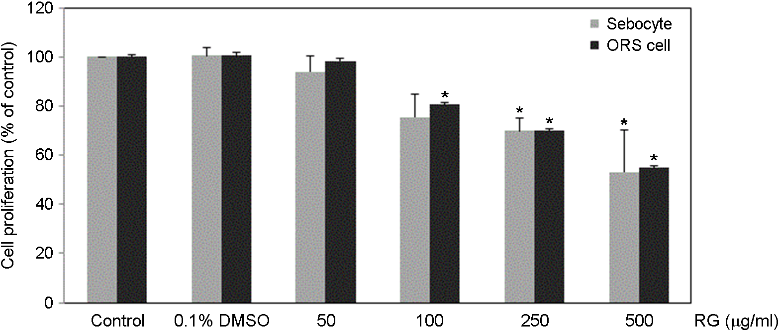
To investigate the effect of RG on sebocytes and ORS cells in the presence of acne-causing bacteria, we treated the cells with LPS to induce inflammation mediated by Propioni- bacterium acnes1. We examined the changes in inflammatory cytokine expression in sebocytes and ORS cells upon treatment with LPS and/or RG. Real-time PCR analysis demonstrated that LPS treatment increased mRNA expression of inflam- matory cytokines (IL-1β, IL-6, IL-8, and TNF-α) in sebocytes and ORS cells after 6 and 24 h. Interestingly, adding both LPS and RG further augmented the mRNA expression of these inflammatory cytokines compared to LPS treatment alone (Fig. 3A, B). Consistent with these findings, the protein levels of inflammatory cytokines in the conditioned medium were also increased by LPS treatment, and the co-treatment with RG further enhanced the LPS-induced induction of inflammatory cytokines (Fig. 3C-F). The effects of RG on the production of inflammatory cytokines in LPS-treated sebocytes and ORS cells were further confirmed using real-time PCR and ELISA.
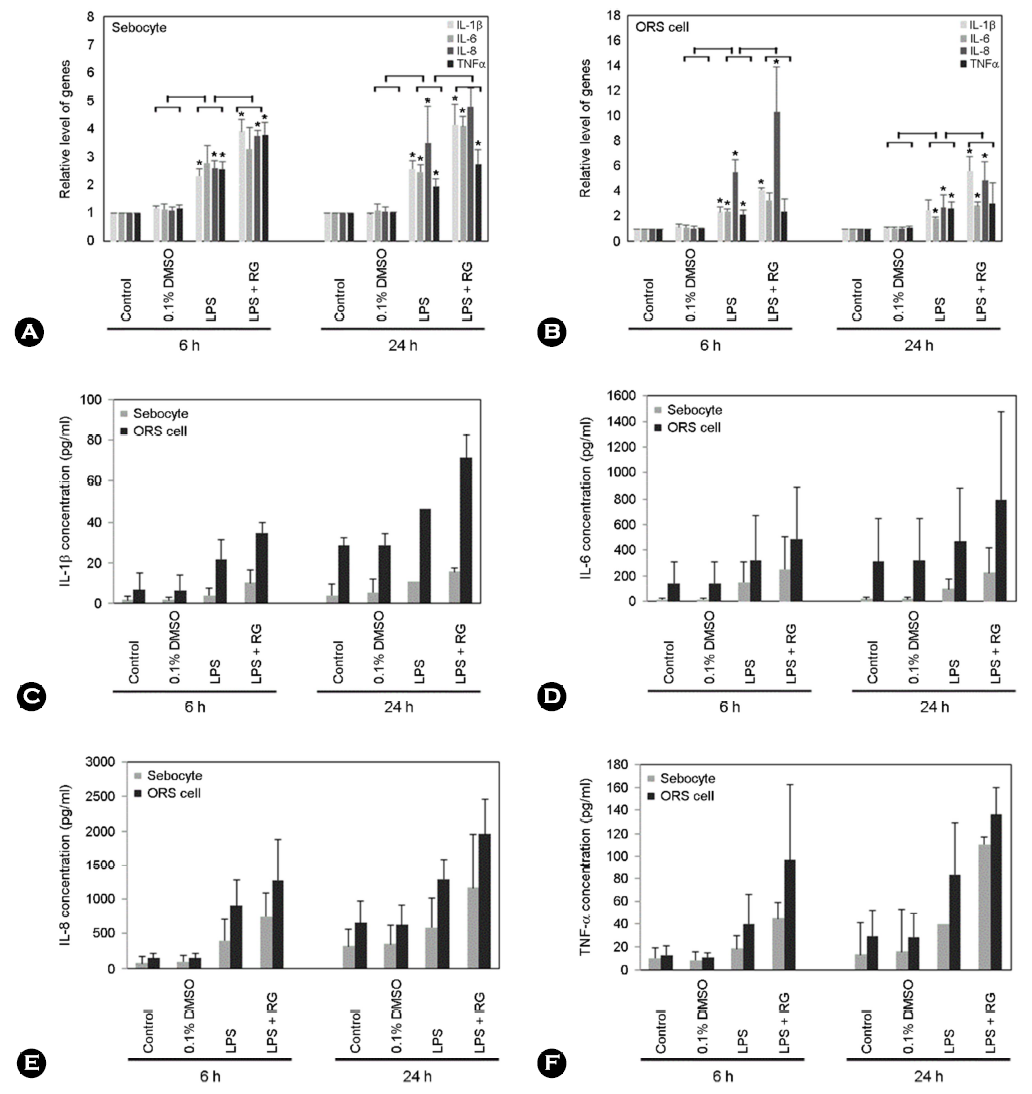
Furthermore, we investigated the underlying mechanisms through which RG water extract modulates the expression of inflammatory cytokines in LPS-treated sebocytes and ORS cells. We focused on the NF-κB and JNK pathways, which are known to activate inflammatory gene transcription upon LPS stimulation. Western blot analysis revealed that the phos- phorylated NF-κB (p-NFκB) level in the nucleus significantly increased after 6 h of LPS exposure. The addition of RG along with LPS further enhanced the accumulation of p-NFκB in the nucleus of sebocytes and ORS cells (Fig. 4A). Consistent with these results, immunofluorescence staining demonstrated increased translocation of NFκB into the nucleus in LPS-treated sebocytes and ORS cells upon treatment with RG (Fig. 4B).
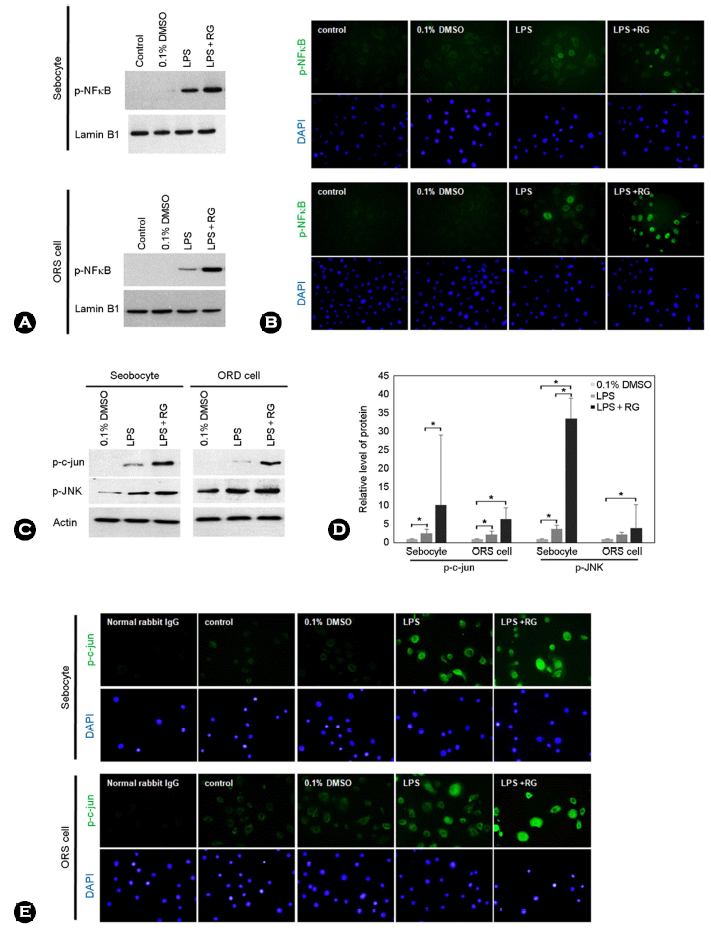
Moreover, we examined the expression levels of the JNK pathway. Western blot analysis showed increased expression of phosphorylated c-Jun (p-c-jun) and phosphorylated JNK (p-JNK) in LPS-treated sebocytes and ORS cells after 6 h of treatment with RG (p < 0.05) (Fig. 4C, D). Immunofluorescence staining also revealed increased expression of p-c-jun in LPS-treated sebocytes and ORS cells following treatment with RG (Fig. 4E).
2. RG water extract increases the production of sebum in LPS-treated sebocytes
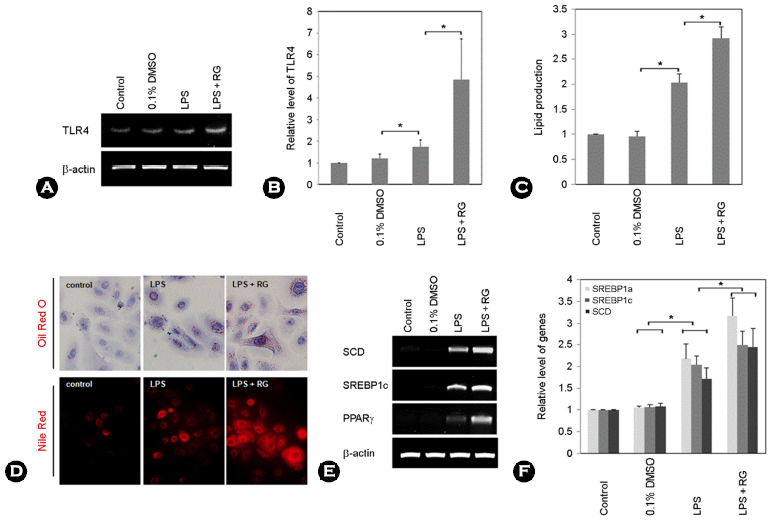
LPS is a component found in gram-negative bacteria and is an immunostimulatory factor9. Toll-like receptor 4 (TLR4) primarily mediates cellular signaling induced by gram-negative bacteria10. To investigate the impact of LPS treatment on human sebocytes, we examined the expression level of TLR4. Our findings demonstrated that LPS treatment increased the expression of TLR4. Notably, RG further enhanced the expression of TLR4 in LPS-treated sebocytes after 24 h, as observed in RT-PCR analysis (Fig. 5A, B).
Subsequently, we explored whether RG plays a role in sebum production in LPS-treated sebocytes. After 24 h of RG treatment, the production of sebum was observed to increase in LPS-treated sebocytes (Fig. 5C). Nile red staining and oil red O staining revealed an augmented accumulation of lipid droplets in the perinuclear cytoplasm of LPS-treated sebocytes upon RG treatment (Fig. 5D). To further confirm sebum production, we examined the expression of genes associated with sebum secretion in RG-treated, LPS-treated sebocytes. RT-PCR analysis revealed that RG enhanced the expression of sebum secretion-related genes in LPS-treated sebocytes (Fig. 5E). Consistent with these results, RG also up- regulated the expression of several lipogenic-regulated genes (SCD; Stearoyl-CoA Desaturase, SREBP1c; Sterol regulatory element-binding protein 1c; PPARγ; Peroxisome proliferator-activated receptor gamma) as determined by real-time PCR (Fig. 5F).
3. RG water extract delayed the improvement of inflammatory nodules in mice
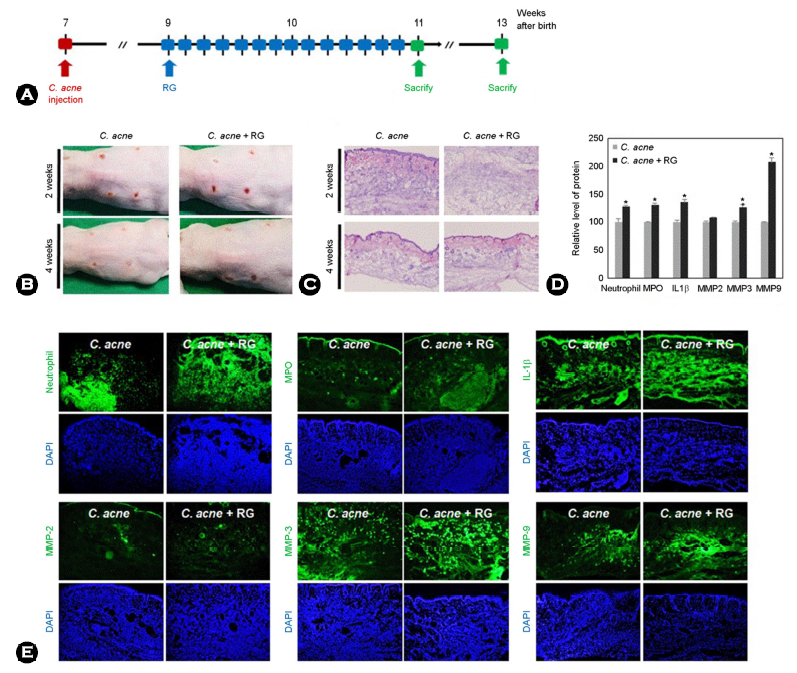
To assess the impact of RG on C. acnes-induced skin in- flammation, we intradermally injected C. acnes suspensions into four sites on the mice's back skin. After 24 h, the mice were orally administered RG for 2 weeks (Fig. 6A). The group receiving oral RG treatment exhibited aggravated inflamed nodules compared to the control group (Fig. 6B). Hematoxylin and eosin (H&E) staining revealed more severe inflammatory nodules in RG-treated mice compared to the control group at both week two and week four (Fig. 6C).
C. acnes trigger TLR2 activation, leading to the release of neutrophil chemoattractant cytokines. Inflammatory nodules induced by C. acnes consist of various inflammatory cells, including neutrophils and T cells11. Consequently, we exam- ined the expression of inflammatory and tissue remodeling markers. Firstly, we observed that the group treated with RG and C. acnes exhibited increased expression of TLR2 compared to the group treated with only C. acnes (data not shown). Immunofluorescence staining demonstrated elevated expression of inflammatory biomarkers such as neutrophils, myeloperoxidase (MPO), IL-1β, and tissue remodeling bio- markers, including metalloproteinases (MMP)-2, MMP-3, and MMP-9 in the RG-treated group (Fig. 6D, E).
Furthermore, antimicrobial peptides, including LL37, can protect against C. acnes or induce inflammatory signals in acne vulgaris. In our study, LL37, one of the antimicrobial peptides, showed increased expression in LPS-treated sebo- cytes and ORS cells treated with RG and in mice administered RG and C. acnes (Fig. 7A, B).
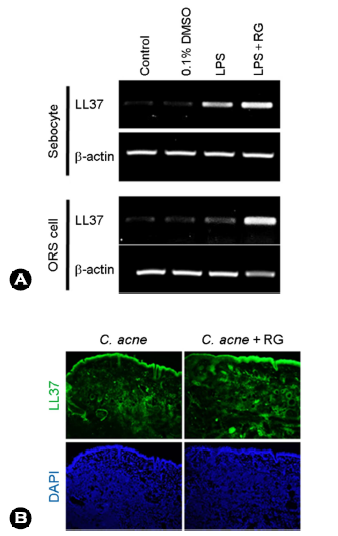
Inflammation is a complex response that is crucial in defense against pathogens. However, excessive inflammation can result in the overexpression of inflammatory cytokines and chemokines. Panax ginseng, known for its anti-inflammatory effects, has been traditionally used to regulate inflammation in the human body. Additionally, Panax ginseng exhibits anti- oxidant properties, helping to eliminate reactive oxygen species. Moreover, Panax ginseng possesses immune-stimulating acti- vities. Studies have shown that RG, especially Rg3-enriched RG extract, exhibits superior antioxidant and immune-stimulating effects compared to black and fermented RG. This extract has been investigated for its anti-inflammatory and anti- oxidant properties12.
The anti-inflammatory effects of Panax ginseng are attri- buted to its ability to inhibit proinflammatory cytokines and suppress the synthesis of interleukins and key inflammation-related pathways such as NF-kB and TLR2-7. When LPS binds to Toll-like receptor 4 (TLR4), it activates the inflammatory signaling pathway involving inducible nitric oxide synthase and cyclooxygenase-2. These mediators stimulate the pro- duction of proinflammatory cytokines, such as IL-1β and TNF-α. TLR4-LPS binding leads to TGF-β activated kinase 1 (TAK1) activation through phosphorylation.
Phosphorylated TAK1 then activates IκB kinase (IKK α/β) via phosphorylation, which in turn phosphorylates and activates IκBα. Phosphorylated IκBα releases NF-κB, allowing it to trans- locate into the nucleus and initiate the transcription of inflammation-associated genes13. Similarly, the MAPK pathway, consisting of upstream factors (MKK and MEK) and down- stream factors (ERK, JNK, and P38), also contributes to the initiation of inflammation14,15. Rg3-RGE inhibits the phos- phorylation of all factors in the NF-κB and MAPK pathways.
In line with these findings, our study demonstrated that LPS-induced the expression of proinflammatory cytokines by activating the NF-κB and JNK pathways in human sebocytes and ORS cells. Surprisingly, we observed that inflammation was further exacerbated after treatment with RG and LPS. This discrepancy may be attributed to cellular differences. Our study utilized sebocytes and ORS cells, where RG treatment augmented the expression of inflammatory cytokines (IL-1β, IL-6, IL-8, TNF-α) and LL-37 in response to LPS. Moreover, the activation of NF-κB, p-c-jun, and p-JNK was significantly higher in sebocytes and ORS cells treated with RG and LPS. LPS-pre-treated sebocytes exhibited increased production of sebum lipids and upregulated expression of sebum secretion-related genes upon RG treatment. Furthermore, RG worsened acneiform eruptions induced by C. acnes in HR-1 mice, as evidenced by delayed improvement of inflammatory nodules in H&E staining. Immunohistochemistry also revealed increased expression of inflammatory biomarkers in RG-administered mice compared to the control group.
In conclusion, treatment with RG led to an increase in the expression of inflammatory cytokines in cultured sebocytes and ORS cells when exposed to LPS. Moreover, the adminis- tration of RG resulted in a delay in the improvement of inflammatory nodules in mice. Therefore, RG may act as an aggravating factor for inflammatory acne, possibly due to its immune-boosting effects on proinflammatory reactions and sebum production. Consequently, it is advised that patients with inflammatory acne avoid using RG.
STATISTICAL ANALYSIS
The data are presented as means ± standard deviation (SD). Statistical analysis was performed using ANOVA. A significance level of p < 0.05 was considered statistically significant.
DATA SHARING STATEMENT
The data that support the findings of this study are available from the corresponding author upon reasonable request.
ETHICAL APPROVAL STATEMENT
This study was conducted per the principles of the Dec- laration of Helsinki. Written informed consent was obtained from the patient. The study was approved by the Medical Ethical Committee of Kyungpook National University Hospital (Daegu, Korea) (IRB No. KNUH 2021-03-006-001). Animal care and treatment protocols followed the guidelines for using Laboratory Animals and were approved by the In- stitutional Animal Care and Use Committee of Kyungpook National University (IRB No. KNU 2018-167). The study was conducted in compliance with the ARRIVE guidelines.
AUTHOR CONTRIBUTION
MHK and WJL contributed to the design and execution of the experiments. MHK and WJL provided essential reagents, analyzed the data, and contributed to manuscript writing. WJL supervised the research.
References
1. Winston MH, Shalita AR. Acne vulgaris. Pathogenesis and treatment. Pediatr Clin North Am 191;38:889-903
Google Scholar
2. Dinarello CA. Proinflammatory cytokines. Chest 2000; 118:503-508
Google Scholar
3. Hyun MS, Hur JM, Shin YS, Song BJ, Mun YJ, Woo WH. Comparison study of white ginseng, red ginseng, and fermented red ginseng on the protective effect of LPS-induced inflammation in RAW 264.7 cells. J Appl Biol Chem 2009;52:21-27
4. Jang A, Sueng YC, Ji J. The comparative study on physio- logical activity of White ginseng, Red ginseng and Black ginseng extract. J Digit Converg 2016;4:459-471
5. Jin Y, Kim YJ, Jeon JN, Wang C, Min JW, Noh HY, et al. Effect of white, red and black ginseng on physicochemical properties and ginsenosides. Plant Foods Hum Nutr 2015; 70:141-145
Google Scholar
6. Kim J, Ochoa MT, Krutzik SR, Takeuchi O, Uematsu S, Legaspi AJ, et al. Activation of toll-like receptor 2 in acne triggers inflammatory cytokine responses. J Immunol 2002;169:1535-1541
Google Scholar
7. Sohn SH, Kim SK, Kim YO, Kim HD, Shin YS, Yang SO, et al. A comparison of antioxidant activity of Korean White and Red Ginsengs on H2O2-induced oxidative stress in HepG2 hepatoma cells. J Ginseng Res 2013;37:442-450
Google Scholar
8. Kwack MH, Kim JC, Kim MK. Ectodysplasin-A2 induces apoptosis in cultured human hair follicle cells and pro- motes regression of hair follicles in mice. Biochem Biophys Res Commun 2019;520:428-433
Google Scholar
9. O'Neill AM, Gallo RL. Host-microbiome interactions and recent progress into understanding the biology of acne vulgaris. Microbiome 2018;6:177
Google Scholar
10. Oliveira-Nascimento L, Massari P, Wetzler LM. The Role of TLR2 in Infection and Immunity. Front Immunol 2012; 3:79
Google Scholar
11. Kim YJ, Kim DW, Chang CC. Carbon tetrachloride (CCl4)-induced mouse liver damage and antioxidant activities of aqueous extracts of white, red, and fermented red ginseng. J Trace Anal Food Drugs 2013;1:22-29
Google Scholar
12. Kim WY, Kim JM, Han SB, Lee SK, Kim ND, Park MK, et al. Steaming of ginseng at high temperature enhances biological activity. J Nat Prod 2000;63:1702-1704
Google Scholar
13. Zhang W, Liu HL. MAPK signal pathways in the regulation of cell proliferation in mammalian cells. Cell Research 2002;12:9-18
Google Scholar
14. Burotto M, Chiou VL, Lee JM, Kohn EC. The MAPK path- way across different malignancies: a new perspective. Cancer 2014;120:3446-3456
Google Scholar
15. Tournas VH, Kohn JS, Katsoudas EJ. Interactions be- tween various microbes and ginseng botanicals. Crit Rev Microbiol 2011;37:113-120
Google Scholar
Congratulatory MessageClick here!